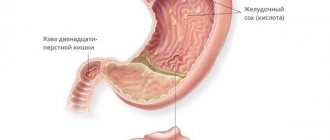Zollinger-Ellison syndrome is a whole complex of symptoms that arise against the background of high levels of gastrin in the blood, which is produced by a hormonally active neoplasm. Often the tumor forms in the pancreas, but can form in the duodenum. A characteristic feature of such a tumor is that it is almost always benign, but can transform into oncology and metastasize to nearby internal organs.
- Etiology
- Classification
- Symptoms
- Diagnostics
- Treatment
- Complications
- Prevention
At present, the mechanism of development of this disease has not yet been fully studied. However, clinicians claim that such a symptom complex is diagnosed several times more often in males than in females. The risk group consists of people from twenty to fifty years of age, but the possibility of the disease occurring in children cannot be ruled out.
There are no characteristic clinical manifestations of this disease. Often gastrinoma is expressed in intense pain, profuse diarrhea and other symptoms characteristic of other gastrointestinal ailments.
Diagnosis is based on a wide range of both instrumental and laboratory examinations. Treatment for this disorder is complex and consists of surgical intervention in combination with medication.
Etiology
Today, gastroenterologists have not fully elucidated the causes and mechanism of gastrinoma formation. However, several predisposing factors have been identified:
- complicated heredity - clinicians have noted that such a disease can be transmitted from mother to child;
- a genetic disease such as multiple endocrine neoplasia type 1. This disorder combines the formation of numerous small tumors without a clear location in the affected organ and peptic ulcers in the small intestine, in particular in the duodenum and small intestine;
- hyperplasia of gastrin-producing cells of the stomach in its antrum. With this disease, gastrin secretion is not regulated in any way, which becomes the cause of uncontrolled hypergastrinemia.
Gastrinomas are single or multiple dark red nodules. They have a round or oval shape, dense consistency and small volumes - no more than two centimeters.
Classification
There is only one classification of this disorder - depending on the location of the gastrin-producing tumor. Thus, the disease can affect:
- pancreas – in 85%;
- antrum of the stomach – 10%;
- duodenum – less than 5%;
- extremely rarely such organs as the spleen and liver, gall bladder, omentum and ovaries.
"Triangle of gastrinoma"
Pancreatic gastrinoma, in turn, can involve in the pathological process:
- head;
- body;
- the tail of this organ.
The last two localization locations are the most common.
Diagnostic methods
The main goal of diagnostic procedures is to exclude the presence of pancreatic tumors. This allows you to avoid misdiagnosis and develop further treatment for gastritis.
The main diagnostic methods are:
- taking anamnesis;
- examination of the patient with palpation;
- radiography (necessary to identify ulcers);
- blood test (the results indicate an increased level of gastrin);
- determination of the acidity of stomach contents;
- ultrasound examination of the abdominal organs (to detect a pancreatic tumor);
- CT scan.
Diagnosis of the syndrome includes a wide range of procedures necessary to exclude other pathologies and determine the nature and characteristics of gastrointestinal lesions.
Symptoms
During the diagnosis of Zollinger-Ellison syndrome, a peptic ulcer of the duodenum or stomach is discovered, which is resistant to antiulcer treatment. It follows from this that such a disease has practically no specific external signs. However, symptoms of Zollinger-Ellison syndrome include:
- high intensity pain syndrome in the upper abdomen. This symptom is expressed in the vast majority of patients, namely in males. The severity of the pain increases after a meal, as when deep ulcers appear in the stomach, or immediately after sleep - on an empty stomach, which is typical for duodenal ulcer;
- bowel dysfunction, which manifests itself in diarrhea, is a symptom of such an illness characteristic of the fairer sex. In most cases it is the only expression of the clinical picture. Fecal masses are distinguished by their abundance, watery consistency and the presence of particles of undigested food and fat;
- heartburn and burning in the chest area - these signs are often mistaken for GERD;
- belching with an unpleasant odor.
Doctors also identify several rarer symptoms of gastrinoma:
- attacks of nausea and vomiting;
- internal hemorrhages;
- a significant decrease in body weight as the body’s response to profuse diarrhea. Often this sign indicates malignancy of a gastrin-producing tumor;
- pallor or yellowness of the skin.
Zollinger-Ellison syndrome
Zollinger-Ellison syndrome
Gastrin-producing tumor, what is it? This disease was described back in 1955 by two independent scientists, after whom the pathology was named. Patients who turned to them for help had similar symptoms. These patients had abnormal bowel movements, increased acidity, and tumors in the islet part of the pancreas. Scientists have suggested a relationship between these tumors and multiple ulcers in the stomach. It was later discovered that the tumor produces gastrin in large quantities.
Symptoms
Hypergastrinemia in most cases manifests itself as chronic diarrhea. This is due to increased acid formation. The alkaline environment of the stomach cannot cope with the amount of hydrochloric acid that comes from the stomach. As a result, the jejunal part of the intestine encounters unusual acidic contents, which have a damaging effect on the mucous membrane of the organ. With prolonged and regular contact, inflammation occurs, suppression of enzymatic activity, and impaired absorption of fluids and electrolytes. In many cases, diarrhea is the only symptom in patients with Zollinger-Ellison syndrome.
Localization of gastrinoma
In some patients, due to the existing insufficiency of the cardiac sphincter of the stomach, reflux esophagitis develops. With frequent reflux of acidic contents into the cavity of the esophagus, inflammation occurs and a change in the epithelium from multilayered squamous to cylindrical. This condition is called Barrett's esophagus. It is a precancerous disease that requires immediate treatment and acid-lowering therapy.
Many people around the world suffer from various painful disorders of the gastrointestinal tract. One of the most painful and uncomfortable diseases is stomach ulcer. The main manifestation of this pathology is defective damage to the mucous and often submucosal lining of the stomach due to the harmful effects of hydrochloric acid, as well as bile and the proteolytic enzyme pepsin. Ulcerative lesions in other parts of the gastrointestinal tract are also common, for example: ulcerative processes in the duodenum, erosive esophageal esophagitis and others.
Such drugs as proton pump inhibitors exhibit effective therapeutic effects against these diseases. One of the most effective drugs in this category is Omez. The main medicinal property of this medication is to suppress stimulated as well as basal production of hydrochloric acid, which reduces the painful effect on the affected area of the organ and promotes its speedy healing. The effect of this medication occurs one hour after a single dose and continues to work throughout the day.
Omez is an effective and powerful proton pump inhibitor
In this article we will tell you in detail about the basic principles of the pharmacological action of the drug, describe the main indications for the use of Omez, side effects and contraindications.
Important! This article is not an exact guide to action. Do not start treatment on your own. If you experience any symptoms of the disease, you should immediately contact your physician or other qualified healthcare professional.
Diagnostics
To establish a final diagnosis, a wide range of laboratory and diagnostic measures will be required, which is due to the similarity of this disorder with other diseases of the digestive system.
Primary diagnosis is aimed at performing:
- detailed patient interview;
- familiarizing the doctor with the patient’s medical history and life history;
- a thorough physical examination, which must include palpation of the abdomen.
This is what will enable the gastroenterologist to learn more about the factors in the formation, presence and intensity of the symptoms of such a disease.
Laboratory diagnostic techniques include:
- general and biochemical blood test;
- clinical urine analysis;
- microscopic examination of stool - paying attention to the consistency and amount of fat in the stool;
- determination of gastrin concentration in the blood;
- performing secretin and calcium tests;
- breath test to detect the bacteria Helicobacter pylori.
However, the most valuable methods for instrumental diagnosis of Zollinger-Ellison syndrome are:
- FEGDS - for examining and assessing the condition of the inner surface of the mucous layer of the esophagus, stomach and the initial part of the duodenum;
- A biopsy is the removal of a small piece of the affected organ, which is carried out during a previous procedure. The need for a biopsy is to determine the malignant or benign course of the disease;
- Ultrasound of the abdominal organs - to confirm the location of the gastrin-producing tumor;
- CT and MRI.
To establish the correct diagnosis using the diagnostic measures described above, the gastroenterologist must differentiate gastrinoma from the following ailments:
- ulcers of the upper gastrointestinal tract, which scar poorly and often recur;
- celiac disease;
- malignant or benign tumors of the small intestine;
- gastritis.
Diagnosis of the syndrome
Since the symptoms of Zollinger-Ellison syndrome are very similar in appearance to peptic ulcer disease, the task of differential diagnosis is to confirm or exclude the presence of a tumor. X-rays and endoscopy will reveal the presence of ulcers, but not the tumor, which is the underlying cause. Zollinger-Ellison syndrome is indicated by an increased level of gastrin in the blood (up to 1000 pg/ml versus 100 pg/ml for peptic ulcer disease). Another distinctive feature is the acidity of the main secretion more than 100 mmol/h. When diagnosing, you should be wary if the ulcerative lesion is multiple in nature, or if the ulcers are located quite unusually.
If these signs are present, a study can be prescribed using ultrasound, computed tomography and, especially, selective abdominal angiography, which will allow visualization of the tumor.
Treatment
Drug treatment for Zollinger-Ellison syndrome is aimed at reducing the production of acidic gastric contents, which can be achieved by taking:
- histamine H2 receptor blockers, PPIs;
- selective M-anticholinergics.
H2-histamine receptor blockers
If conservative therapy is ineffective, they resort to surgical treatment, which is performed in several ways:
- complete removal of the tumor. However, due to the fact that metastases are detected during surgery, complete cure using such operable tactics is achieved only in every third patient with a similar diagnosis;
- excision of the stomach using selective vagotomy and pyloroplasty - has low effectiveness, because ulcers may be prone to relapse;
- total gastrectomy – indicated only if complications develop.
In cases where gastrinoma has become malignant, as well as in those patient conditions where surgery is impossible, chemotherapy is used.
Complications
Since ulcers in Zollinger-Ellison syndrome are resistant to standard antiulcer therapy, they are very often prone to developing complications that can threaten the patient's life. These include:
- ulcer perforation;
- diffuse peritonitis;
- formation of strictures;
- hemorrhages;
- loss of body weight to the point of extreme exhaustion;
- dysfunction of the heart;
- spread of gastrinoma metastases to regional internal organs;
- compression of the bile ducts.
What it is?
A tumor in the pancreas increases the secretion of the hormone gastrin, which increases the number of stomach cells responsible for the production of acid involved in the digestion of food. Normally, gastrin is always produced, but in strictly limited quantities. The hormone increases acid secretion, while a sufficient amount of it is a stop signal for the production of the hormone. In Zollinger-Ellison syndrome, this process is not controlled: gastrin causes excess gastric juice, which, in turn, affects the amount of gastrin. A vicious circle is formed.
Hydrochloric acid in normal quantities is completely harmless, but its constant presence in the internal environment leads to the formation of ulcers.
These ulcers have several unpleasant features:
- provoke constant diarrhea;
- almost untreatable;
- prone to reappear after therapy.
Gastrinoma is not always located in the pancreas. Sometimes she chooses a different location: the stomach, duodenum or lymph nodes located near the pancreas.
Anatomically, the tumor has the form of connected nodules of red, yellow or gray color. The cluster of nodules is almost always round and dense. The size of the neoplasm ranges from 1-3 mm to 1-3 cm.
Prevention
There are no specific preventive measures against the formation of Zollinger-Ellison syndrome. However, people need to adhere to the following rules:
- proper and rational nutrition - this means minimizing the consumption of fatty and spicy foods, smoked and fast food, carbonated drinks and coffee;
- completely give up bad habits;
- If possible, avoid stressful situations and nervous tension;
- undergo regular examinations with a gastroenterologist.
The prognosis for this disease is only slightly better than for other malignant neoplasms. Five-year survival rate in the presence of metastases reaches 50–80%, after surgical treatment – 70–80%.









